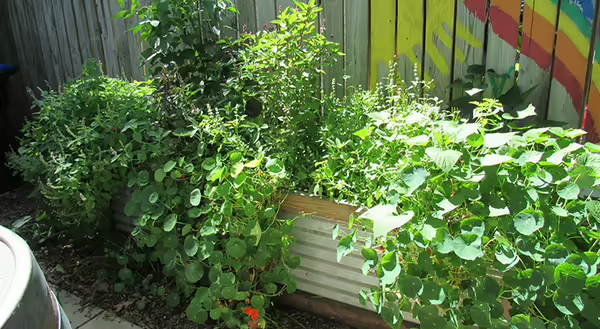
Homesteading provides a unique life path, and it is growing in popularity. The lifestyle focuses on self-sufficiency and natural settings, from growing produce and raising livestock to using natural remedies and beekeeping. For Bloomington residents Chris Stenger and his wife Sarah, urban homesteading is their answer to the recent question of how to have a more fulfilling life, given modern life’s demands.
Useful Yard Company
I caught up with Chris on the “Homestead” on a hot, sunny day in the end of August. The Stengers now own and operate Useful Yard Company, an urban homestead business started in 2021 in Bloomington. Useful Yard offers a variety of products through several outlets, from native and non-native plants, shrubs, and tree transplants in the springtime; excess fresh produce throughout the harvest season; and Cottage Food items like drink mixes, pickles, salsas.
Extension Inspires
I spotted a few black currants, asked where they came from, and was delighted by Chris’ response. Years ago, Chris took an Illinois Extension plant propagation and grafting class with Bill Davison, former local food systems and small farms Extension educator, and participants were sent home with black currant cuttings to try to grow out into mature plants. The currants are living proof of Chris’ green thumb, and Extension’s successful teaching.
“That class really got me thinking about how to propagate my own plants,” Chris said. “Instead of buying more plants, I could clone my own, for free. It didn’t seem like a whole lot at the time, but the way it turned out, it was instrumental to my business plan.” It was wonderful to hear about the impact that Illinois Extension has had on Stengers’ journey; however, their journey is generations in the making.
All in the Family
Chris’ father, Michael Stenger, grew up on the land, the oldest of seven siblings. Chris’ grandfather, Edward Stenger, had an eighth-grade education and was a welder at Caterpillar. His grandmother, Betty Stenger, was a homemaker, and when she was not providing childcare, she tended a large vegetable garden. Michael grew up eating both fresh and preserved produce and became interested in agriculture.
While pursuing an agriculture degree at University of Illinois, he learned tree grafting techniques — bench grafting as well as T-bud grafting — and developed the skills he needed to help his parents incorporate fruit trees into their homestead landscape. Soon, there were apple, peach, and pear harvests to add to the annual vegetable garden bounty. Chris spent many vacations and weekends on the family homestead, surrounded by useful plants and trees. “The gears began to turn,” says Chris.
The Journey Begins
Chris and Sarah moved to Bloomington in 2001, but it wasn’t until 2010 that the homesteading activities began in earnest. That fall, the entire front yard was covered in a thick layer of cardboard, compost, and fresh hardwood woodchips. The following spring, they planted shade-tolerant annual and perennial herbs, fruits, and useful ground covers. So long, lawn. Hello, urban farm.
The specific shade-tolerant species selections for this site — alpine strawberries, black, white, and red currants, lemon balm, creeping thyme, elderberry, sage, and more — fit well with the mature, shade-casting sycamore trees that flank the front yard, and is an excellent example of working with the existing native landscape, instead of against it.
Mushrooms
Another Useful Yard inhabitant was hiding in plain sight, directly underfoot in the woodchips: Winecap mushroom, (Stropharia rugosoannulata). Commercial inoculant of this mushroom species can be purchased and interspersed with fresh hardwood wood chips, and – if kept moist – the inoculant will grow mycelium that consumes woodchips, produces soil-building organic matter, and interlinks perennial plant roots with its mycelial networks. Those networks, in turn, can share nutrients and water with host plants, all while generating delicious mushrooms once or twice a year.
Greenhouses, Raised Beds, Cold Frames and Rain Gardens
Additionally, Chris showed me a cold frame that currently holds a small ginger root crop — an up-and-coming specialty crop in Illinois. Rounding out the tour, I was amazed by paths throughout the yard flanked by pollinator host plants like Purple Coneflower and Black-Eyed Susan; a back lot line row of apple, peach, pear, and pawpaw trees; and a hand-dug raingarden, a once flood-prone spot, now a useful feature.
Cottage Food Success
Two examples of their Cottage Food products are a ginger and herb drink mixer, as well as candied ginger. Useful Yard Company has worked with McLean County Department of Health and Bellis Labs in Decatur to recipe-test these products, and they will hit the shelf soon, thanks to the Illinois Cottage Food Law and its latest revisions.
Research and Resources
When asked what type of educational resources are most beneficial to their business, Chris had this to say: “Specialty crops research like the ginger trials at the Unity Community Center are integral to businesses like mine. They help develop the crop sciences research expertise to better support the on-the-ground growing of new crops for farmers, as well as help to build consumer demand and markets.”
Other favorite Useful Yard resources include Extension programs at the Refuge Food Forest, grants, educational resources, and events available from the Land Connection in Champaign and Edible Acres, a perennial plant nursery and educational YouTube presence based in Trumansburg, New York.
Make Your Own Yard Useful —Slowly
“Take it one step at a time. It’s a process. Don’t give up when something dies, or something doesn’t work right. Anybody that’s ever grown anything successfully can tell you about all the plants they killed before that success. Make sure to enjoy the ride!”
As I got back in my car and ate my candied ginger, my mouth was tingling and my brain was churning. How can I start to make my own yard more useful and stop spending as much time and money mowing the grass? How can we get our home landscapes to work for us, for birds, for insects, for our neighbors?